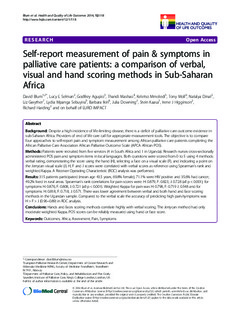| dc.contributor.author | Blum, David | |
| dc.contributor.author | Selman, LE | |
| dc.contributor.author | Agupio, G | |
| dc.contributor.author | Mashao, T | |
| dc.contributor.author | Mmoledi, K | |
| dc.contributor.author | Moll, T | |
| dc.contributor.author | Dinat, N | |
| dc.contributor.author | Gwyther, L | |
| dc.contributor.author | Sebuyira, LM | |
| dc.contributor.author | Ikin, B | |
| dc.contributor.author | Downing, J | |
| dc.contributor.author | Kaasa, Stein | |
| dc.contributor.author | Higginson, Irene J. | |
| dc.contributor.author | Harding, Richard | |
| dc.date.accessioned | 2015-09-29T12:40:37Z | |
| dc.date.accessioned | 2015-10-16T10:51:34Z | |
| dc.date.available | 2015-09-29T12:40:37Z | |
| dc.date.available | 2015-10-16T10:51:34Z | |
| dc.date.issued | 2014 | |
| dc.identifier.citation | Health and Quality of Life Outcomes 2014, 12(1) | nb_NO |
| dc.identifier.issn | 1477-7525 | |
| dc.identifier.uri | http://hdl.handle.net/11250/2356328 | |
| dc.description.abstract | Background: Despite a high incidence of life-limiting disease, there is a deficit of palliative care outcome evidence in
sub-Saharan Africa. Providers of end of life care call for appropriate measurement tools. The objective is to compare
four approaches to self-report pain and symptom measurement among African palliative care patients completing the
African Palliative Care Association African Palliative Outcome Scale (APCA African POS).
Methods: Patients were recruited from five services (4 in South Africa and 1 in Uganda). Research nurses cross-sectionally
administered POS pain and symptom items in local languages. Both questions were scored from 0 to 5 using 4 methods:
verbal rating, demonstrating the score using the hand (H), selecting a face on a visual scale (F), and indicating a point on
the Jerrycan visual scale (J). H, F and J scores were correlated with verbal scores as reference using Spearman’s rank and
weighted Kappa. A Receiver Operating Characteristic (ROC) analysis was performed.
Results: 315 patients participated (mean age 43.5 years, 69.8% female), 71.1% were HIV positive and 35.6% had cancer,
49.2% lived in rural areas. Spearman’s rank correlations for pain scores were: H: 0.879, F: 0.823, J: 0.728 (all p < 0.001); for
symptoms H: 0.876, F: 0.808, J: 0.721 (all p < 0.001). Weighted Kappa for pain was H: 0.798, F: 0.719 J: 0.548 and for
symptoms: H: 0.818, F: 0.718, J: 0.571. There was lower agreement between verbal and both hand and face scoring
methods in the Ugandan sample. Compared to the verbal scale the accuracy of predicting high pain/symptoms was
H > F > J (0.96–0.89) in ROC analysis.
Conclusions: Hands and faces scoring methods correlate highly with verbal scoring. The Jerrycan method had only
moderate weighted Kappa. POS scores can be reliably measured using hand or face score. | nb_NO |
| dc.language.iso | eng | nb_NO |
| dc.publisher | BioMed Central | nb_NO |
| dc.title | Self-report measurement of pain & symptoms in palliative care patients: a comparison of verbal, visual and hand scoring methods in Sub-Saharan Africa | nb_NO |
| dc.type | Journal article | nb_NO |
| dc.type | Peer reviewed | en_GB |
| dc.date.updated | 2015-09-29T12:40:37Z | |
| dc.source.volume | 12 | nb_NO |
| dc.source.journal | Health and Quality of Life Outcomes | nb_NO |
| dc.source.issue | 1 | nb_NO |
| dc.identifier.doi | 10.1186/s12955-014-0118-z | |
| dc.identifier.cristin | 1170413 | |
| dc.description.localcode | © 2014 Blum et al.; licensee BioMed Central Ltd. This is an Open Access article distributed under the terms of the Creative Commons Attribution License (http://creativecommons.org/licenses/by/2.0), which permits unrestricted use, distribution, and reproduction in any medium, provided the original work is properly credited. The Creative Commons Public Domain Dedication waiver (http://creativecommons.org/publicdomain/zero/1.0/) applies to the data made available in this article, unless otherwise stated. | nb_NO |
